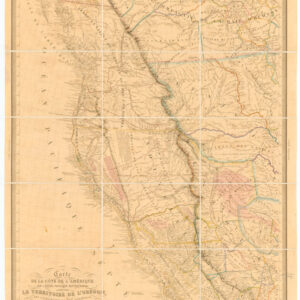An unrecorded bird’s-eye-view of Stockton, California.
Birdseye View of the City of Stockton and Its Industries.
Out of stock
Description
This unusual bird’s-eye-view of Stockton, California, looks east to provide a glorious view of the young city and stunning Central Valley countryside. It appears to have been printed as a box label, but for what product or purpose is unclear.
The view depicts urban features like Stockton’s electric railroads, streets and buildings, and the ships in its channels. Some of the city’s key landmarks at the time stand out particularly, such as the Stockton and Mormon Channels and the new Southern Pacific Railroad. In the distance, we sense the tall peaks of the Sierra Nevada Mountains.
Surrounding the central view are 27 vignettes of public and commercial buildings: landmarks within Stockton. Each of the vignettes is labeled for easy identification. Among the subjects, we find St. Agnes Academy, San Joaquin County Court House, the Avon Theatre, the offices of the Stockton Daily & Weekly Independent, Stockton Insane Asylum, a Masonic Temple, and a scene from Stockton harbor.
Census
The view was originally drawn by C.P. Cook and then lithographed by W.W. Elliot of San Francisco. It was published in 1890 as a promotional broadsheet by E. A. Crennan & Co. of Stockton.
Neatline’s example of this scarce print is a rare variation that we have not encountered before and appears unrecorded in the relevant literature. It is a reduced version of Elliot’s original print – measuring 14 x 8.5 in as opposed to the Crennan broadside’s 21.25 x 35 in – and it has also seen the central title area significantly altered, including the title itself. The references to real estate auctioneers have been replaced by a simplified title banner that reads Birdseye View of the City of Stockton and Its Industries. Interestingly, the label also includes the name of the new printer: Cal.Label & Maccabe L. Co. S.F.
While the original Elliot lithograph (Reps 430) can be found in institutional collections in California and elsewhere, it is pretty scarce on the market. It is, however, the first time we have come across this reduced version of Elliot’s print. Its seeming purpose as a label may imply that this is an unlikely survivor of an edition otherwise destined to perish.
Context is Everything
Nestled in California’s Central Valley, Stockton traces its origins back to 1849, when it was founded by Captain Charles Maria Weber, a German immigrant. Stockton’s early years were tightly entwined with the rapid influx of fortune-seekers during the California Gold Rush. Situated at the confluence of the San Joaquin and Sacramento Rivers, the city swiftly transformed into a vital transportation hub as steamboats plied the waterways, ferrying miners and goods to the goldfields and agricultural markets. The discovery of gold in the nearby Sierra Nevada foothills rapidly accelerated the growth of Stockton further, serving as a supply hub for miners and pioneers alike.
As the Gold Rush subsided, Stockton transitioned into an agricultural center, capitalizing on its strategic location by the two fertile lands. With the establishment of the Stockton Deepwater Channel in the late 19th century, the city solidified its role as a major inland port, fostering trade and commerce with the outside world. The arrival of the railroad further cemented Stockton’s economic importance. During this period, Stockton developed into a vibrant urban center, marked by the construction of ambitious iconic structures (e.g. the Stockton Savings and Loan Bank) and the showcasing of an array of architectural styles, ranging from Victorian to Renaissance Revival, many of which are highlighted in the vignettes surrounding this view.
Cartographer(s):
C.P. Cook was an American artist most known for his late 19th-century views of California towns and cities.
Cal Label & MacCabe Lith Co. S.F.Condition Description
Minor wear.
References


![Flag Map of California [Signed in pencil by W.J. Goodacre]](https://neatlinemaps.com/wp-content/uploads/2022/01/NL-01134_thumbnail-scaled-300x300.jpg)
